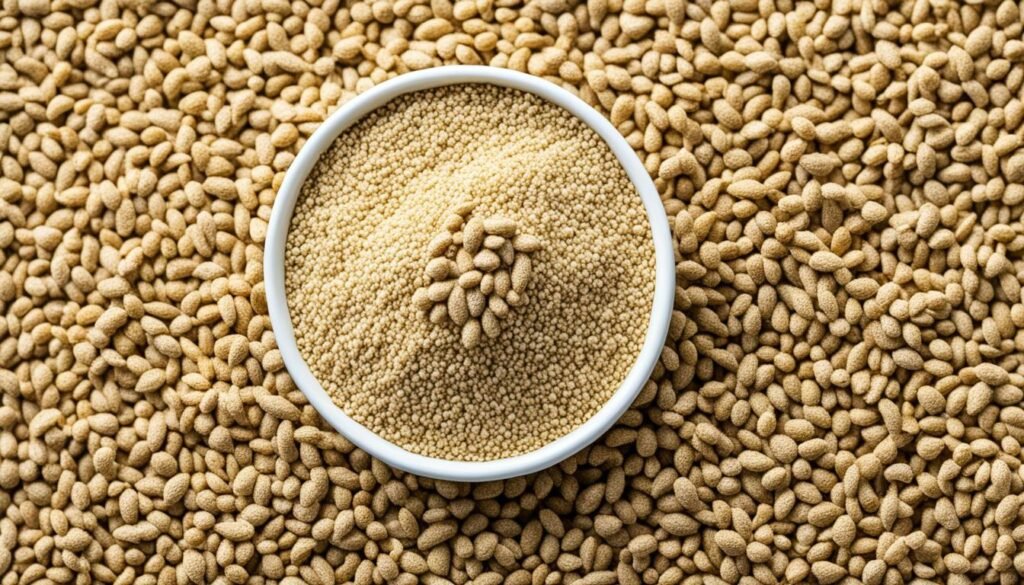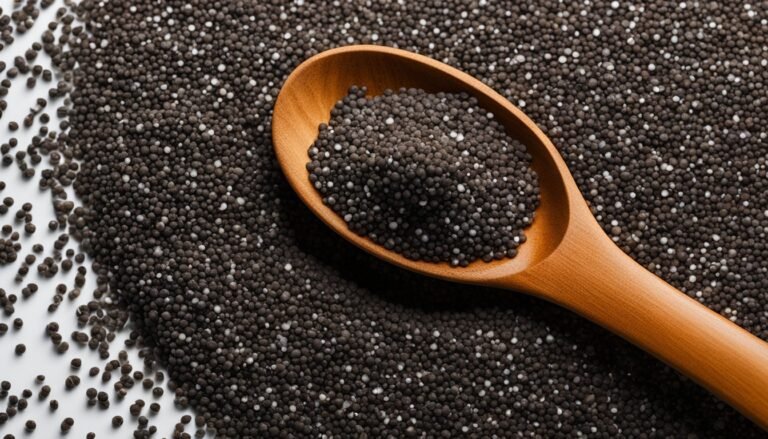Amaranth Seeds in Traditional Medicine: Key Uses

Ever thought about the ancient healing uses of amaranth seeds? This superfood has been a key part of traditional medicine for thousands of years. It’s full of health benefits and has a rich history in Aztec culture. Today, it’s known as a nutritional powerhouse.
Amaranth seeds are like tiny grains but are actually a plant’s seeds. They’re packed with fiber and amaranth seed health benefits. This makes them a great choice for those looking for plant-based protein. For centuries, they’ve been used in ayurvedic properties of amaranth and traditional amaranth remedies.
Amaranth has been around for at least 7,000-8,000 years. It was a major crop in the Aztec Empire. Ancient amaranth seed applications and indigenous amaranth seed uses in traditional medicine are well-documented. Practitioners used holistic amaranth seed treatments and ethnobotanical amaranth practices for various health issues.
So, what makes amaranth seeds so special? Explore the world of uses of amaranth seeds in traditional medicine practices. Discover the amazing amaranth seed health benefits that traditional medicine has found over the years.
Introduction to Amaranth Seeds’ Medicinal Properties
Historical Background and Ethnobotanical Practices
Amaranth is a nutritious plant that has been used in traditional medicine for thousands of years. It was a key crop in the Aztec Empire and is still important today. People have always seen its value for health.
The Aztecs used amaranth for healing. They put its seeds and leaves in remedies. This plant is still a big part of traditional medicine in many places.
Now, scientists are learning why amaranth is so good for us. It’s full of nutrients and has antioxidants and anti-inflammatory effects. This makes it a great food for health.
As we learn more about amaranth, we see the value of old knowledge. Mixing this with new research helps us understand amaranth better. This could lead to new ways to improve our health.
Nutritional Profile and Biological Activities
Amaranth is a versatile pseudo-grain with a great nutritional profile and many biological activities. It is a complete protein, meaning it has all nine essential amino acids. This makes it a key part of a balanced diet. It also has a lot of dietary fiber, which is important for digestion and controlling blood sugar.
The nutritional value of amaranth changes based on the type and how it’s prepared. For example, green morph amaranth can have from 23.11 to 54.98 grams of protein per kilogram of fresh weight. The GRA15 type has the most protein. The fat content ranges from 2.31 to 4.21 grams per kilogram of fresh weight, with GRA17 having the most.
The amaranth fiber content is also significant, averaging about 7.51 grams per 100 grams of fresh weight. This fiber is good for healthy digestion and may help manage chronic conditions.
Amaranth is full of antioxidants, with its types having antioxidant capacities from 27 to 48 μg/g Trolox equivalents. These antioxidants include phenolics, flavonoids, vitamin C, carotenoids, chlorophylls, and betalains. They help protect the body from oxidative stress and may lower the risk of some diseases.
The high amaranth protein content, fiber, and antioxidant properties make it a valuable and health-promoting food. Its versatility lets it be used in many foods, from baked goods to cereals. This is why it’s becoming more popular as a functional food.
In summary, amaranth has an amazing nutritional profile and biological activities. It’s full of protein, fiber, and antioxidants. These qualities make it a great addition to a healthy diet. As research finds more benefits, amaranth is likely to be used more in traditional and modern medicine, and in making functional foods.
Cardiovascular Health Benefits
Amaranth is an ancient superfood that’s good for your heart. It’s packed with nutrients that help manage cholesterol and prevent heart disease. This grain is a great choice for anyone looking to boost their heart health.
Cholesterol Management and Atherosclerosis Prevention
Eating amaranth can lower bad cholesterol and triglycerides. It might also raise good cholesterol. Its antioxidants help protect the heart and stop atherosclerosis, a condition that narrows arteries.
Amaranth is full of protein, fiber, and healthy fats. These nutrients are key to its heart health benefits. Researchers have looked into how amaranth can manage cholesterol and prevent atherosclerosis.
| Nutrient | Amaranth | Corn | Wheat |
|---|---|---|---|
| Protein (%) | 14.0-15.5 | 9.4 | 12.6 |
| Dietary Fiber (g/100g) | 6.7 | 2.3 | 2.4 |
| Magnesium (mg/100g) | 248 | 37 | 138 |
| Iron (mg/100g) | 7.6 | 2.7 | 3.5 |
Studies show amaranth is great for the heart. It can help lower the risk of heart disease. With its unique nutrients, amaranth is a top choice for heart health.
Digestive System Support
Amaranth is an ancient superfood known for its great nutrition and health benefits. It’s a top choice for supporting the digestive system. This grain is packed with both soluble and insoluble fiber, making it great for your diet.
Amaranth fiber benefits include helping with bowel movements. It can ease constipation and diarrhea, and boost gut health. For people with diabetes, amaranth fiber can help control blood sugar by slowing down carb absorption.
Amaranth and gut health go hand in hand. It’s gluten-free, making it perfect for those with celiac disease or gluten intolerance. This is key for digestive health, as gluten-free diets help with symptoms and healing in gluten-related disorders.
Amaranth is also high in protein, which is vital for gut health. These proteins help keep the gut lining strong and support digestion.
Also, amaranth has antioxidants like flavonoids and polyphenols. These protect the digestive system from damage and inflammation. This can lower the risk of diseases like inflammatory bowel disease and colorectal cancer.
Adding amaranth and gut health to your meals is easy and beneficial. You can eat it as a whole grain, use it in baked goods, or add it to your favorite recipes. It’s a smart choice for a healthy lifestyle.

Liver Protection and Detoxification
Amaranth is an ancient superfood that has been studied for its liver-protective and detoxification properties. It contains antioxidants, phytochemicals, and unsaturated fatty acids. These compounds help protect the liver from damage and support detoxification.
Traditional medicine has long known about amaranth’s benefits for the liver. Amaranthus caudatus, a type of amaranth, has been used for centuries to treat liver issues and improve liver health.
Antioxidant and Anti-Inflammatory Properties
Amaranth is full of antioxidants and anti-inflammatory compounds like phenolic acids, flavonoids, and betalains. These help protect liver cells from damage caused by oxidative stress. This is important for preventing liver diseases.
Its anti-inflammatory properties also help reduce inflammation in the liver. This can help prevent conditions like non-alcoholic fatty liver disease (NAFLD) and hepatitis.
Traditional Uses for Liver Health
- In Aztec and Andean medicine, amaranth was used to support liver function and treat liver ailments.
- People used decoctions and infusions from amaranth leaves and seeds for conditions like jaundice, cirrhosis, and hepatitis.
- Its high levels of antioxidants and phytochemicals made it a key ingredient in traditional medicine for liver health.
While more research is needed, studies suggest that adding amaranth to your diet can help your liver. Always talk to a healthcare professional before trying any new supplements or remedies.
Uses of Amaranth seeds in traditional medicine practices
For centuries, amaranth seeds have been key in healing traditions worldwide. They are used in Ayurvedic and ethnobotanical practices for their healing powers. This shows how versatile and helpful the plant is.
In many cultures, amaranth seeds, leaves, and other parts help with health issues. They are used to treat anemia, inflammation, digestive problems, and liver issues. This shows the plant’s long history in folk medicine and its potential benefits.
The Ute people, from the Southwestern United States, have a strong bond with amaranth. They know its healing powers and use it in their traditions. They use the seeds and other parts for food and medicine.
In Ayurvedic medicine, amaranth seeds help with many health problems, like breathing issues and skin problems. They are seen as having anti-inflammatory, antioxidant, and detoxifying properties. This makes them a key ingredient in Ayurvedic remedies.
Across the globe, amaranth is used for different health issues. In South America, it helps with digestive problems, anemia, and liver complaints. In Africa, its leaves are used for skin conditions and reducing fever.
Amaranth’s long history and wide use in traditional medicine suggest it could be very useful today. As we learn more about its medicinal properties, we should respect the knowledge passed down through generations.

| Traditional Uses of Amaranth | Associated Health Benefits |
|---|---|
| Ute People | Food preparation, traditional medicine |
| Ayurvedic Medicine | Respiratory issues, skin conditions |
| South American Traditions | Digestive problems, anemia, liver complaints |
| African Traditions | Skin conditions, fever reduction |
Antioxidant and Anti-Inflammatory Properties
Amaranth is a superfood known for its strong antioxidants and anti-inflammatory effects. It’s full of phytochemicals like polyphenols and flavonoids. These help fight off free radicals and reduce oxidative stress.
Studies show that amaranth can help reduce inflammation. This is great for people with chronic conditions like arthritis, heart disease, and some cancers. It could be a natural way to fight these diseases.
Potential Applications in Chronic Disease Management
Amaranth could be a big help in fighting chronic diseases. It can lower inflammation and reduce oxidative stress. These are key factors in many chronic illnesses.
For example, amaranth antioxidant properties might help with diabetes. Diabetes is a big health issue worldwide. Oxidative stress can lead to serious complications like nerve damage and eye problems. By using amaranth anti-inflammatory effects, researchers hope to reduce oxidative damage in diabetes patients.
There’s also interest in using amaranth for heart health. Its compounds could help lower cholesterol and reduce inflammation. This could be a natural way to keep the heart healthy and lower the risk of heart problems.
More research is needed to fully understand how amaranth can help with chronic diseases. But the early signs are promising. It could be a powerful natural treatment for many health issues.
Gluten-Free and Functional Food Applications
Amaranth is a nutrient-rich seed that’s becoming popular in gluten-free and functional foods. It’s great for people with celiac disease or gluten issues. It also helps make baked goods and snacks more nutritious.
Amaranth is known for being gluten-free. This makes it a safe choice for those with celiac disease or gluten sensitivity. You can use amaranth as a gluten-free ingredient in many foods. For example, amaranth flour can be used in place of regular flour in bread and muffins, making amaranth in baked goods a tasty and healthy option.
Amaranth is also a functional food ingredient. It’s packed with protein, fiber, minerals, and antioxidants. Adding amaranth to foods like snacks, cereals, and pasta can make them more nutritious. This appeals to people who want to eat healthier.
The unique taste and texture of amaranth add to its value in gluten-free and functional foods. Food makers can use these qualities to create new and tasty amaranth for celiac disease and amaranth in baked goods. These products are perfect for those looking for nutritious and delicious food.
The need for gluten-free and functional foods is growing. Amaranth’s versatility and nutritional benefits make it a key ingredient in the food industry. By using amaranth, manufacturers can offer a variety of products that are good for health and fit dietary needs.
Ethnobotanical Knowledge and Cultural Significance
Amaranth has been very important in many cultures for thousands of years. It was a key crop in the Aztec Empire. Today, it’s still used in traditional medicine and cooking by many indigenous groups. The knowledge and traditions about amaranth show its potential health benefits.
In the Quilombola community of Pau D’arco, Brazil, they use 30 plant species for health. Amaranth is one of them, used for high blood pressure, diabetes, pain, and swelling. This shows how important amaranth is in their health practices.
Learning about amaranth‘s history and cultural use can guide modern health research. Mixing traditional knowledge with science helps us understand amaranth‘s health benefits better. This can help improve health and wellness across different cultures.

Worldwide, amaranth is known for its many uses in medicine, food, and as a decorative plant. From the Aztecs to the Quilombola people in Brazil, its history and cultural importance are clear. This shows its lasting value and the need to keep traditional plant knowledge alive.
Emerging Research and Future Perspectives
Amaranth has a long history in traditional medicine, but current research on amaranth is still new. Studies are looking into its effects on heart health, liver function, and fighting chronic diseases. As more research happens, we’ll learn more about how amaranth can help us.
Areas for further study on amaranth include finding out what makes it work and how to make it better. Researchers are also looking into making amaranth into products that can help people stay healthy. This could make amaranth a key part of natural medicine in the future.
Between 2011 and 2020, 1649 studies on Amaranthus were found in the Web of Science. These studies were done by 5180 researchers from 565 places. They included 1612 articles and 37 reviews, showing a steady increase in research on amaranth over ten years.
Worldwide, amaranth yields about 35–40 tons per hectare. In Ethiopia, it’s much lower at 2.25 tons per hectare. Amaranth is packed with protein, fat, and starch, making it a nutritious food.
Some amaranth types, like Mandiira-II and AC-NL, are better for leaves in Ethiopia. Researchers are also looking into adding amaranth to foods like noodles to make them healthier.
Amaranth grains from Ethiopia are full of important minerals like sodium, copper, iron, potassium, magnesium, and zinc. Adding amaranth to food can make it more nutritious, helping people get the nutrients they need.
More research and awareness could help make amaranth a key part of farming and health. In Ethiopia, certain treatments have made amaranth crops grow better and produce more.
With ongoing research, amaranth could become a big part of natural medicine. Future studies might focus on finding out what makes it work best and how to make products from it.
Conclusion
Ancient grain amaranth has a long history in traditional medicine. It offers many health benefits for those who eat it. It helps with heart health, liver function, and fighting inflammation and oxidative stress.
Amaranth is packed with protein, fiber, and antioxidants. As scientists learn more about it, we might see more natural health products. This could make amaranth a key part of modern health routines.
This grain could be a big help for those looking to live healthier naturally. You can add it to your diet or use it in traditional medicine. The uses of amaranth are still growing, offering more ways to improve our health.
FAQ
What are the traditional uses of amaranth seeds in medicine?
For thousands of years, amaranth has been a key part of traditional medicine. It was a major crop in the Aztec Empire. Today, it’s still used in holistic healing by indigenous communities.
People use amaranth seeds, leaves, and other parts for health issues like anemia and digestive problems. It’s also used for liver issues and inflammation.
What are the potential health benefits of amaranth seeds?
Amaranth is packed with protein, fiber, and antioxidants. It has all the essential amino acids, making it a complete protein. This makes it great for heart health and managing cholesterol.
Its fiber and antioxidants also help with digestion and protect the liver. This could reduce the risk of some diseases.
How do the antioxidant and anti-inflammatory properties of amaranth seeds contribute to health?
Amaranth is full of phytochemicals that act as antioxidants. These can fight oxidative stress and help with chronic conditions like arthritis and heart disease. It may also reduce inflammation.
This could help manage or prevent certain diseases. More research is needed to fully understand its effects.
Can amaranth seeds be used in gluten-free and functional food formulations?
Yes, amaranth seeds are gluten-free. They’re great for people with gluten intolerance or celiac disease. They add protein and fiber to foods.
For example, amaranth flour can be used in gluten-free bread and muffins. It makes these foods more nutritious.
What is the cultural and ethnobotanical significance of amaranth seeds?
Amaranth has been important in many cultures for thousands of years. The Aztecs grew it as one of their main crops. It’s still used in traditional medicine and cooking by indigenous communities.
This long history shows its value in holistic healing. It could lead to new uses for amaranth in modern medicine.
What are the current research trends and future perspectives on the medicinal uses of amaranth seeds?
Research on amaranth is growing, but it’s still new. Scientists are looking into its effects on heart health, liver function, and fighting chronic diseases.
As more studies come out, we’ll learn more about amaranth’s health benefits. This could lead to new products and ways to use amaranth in health care.






